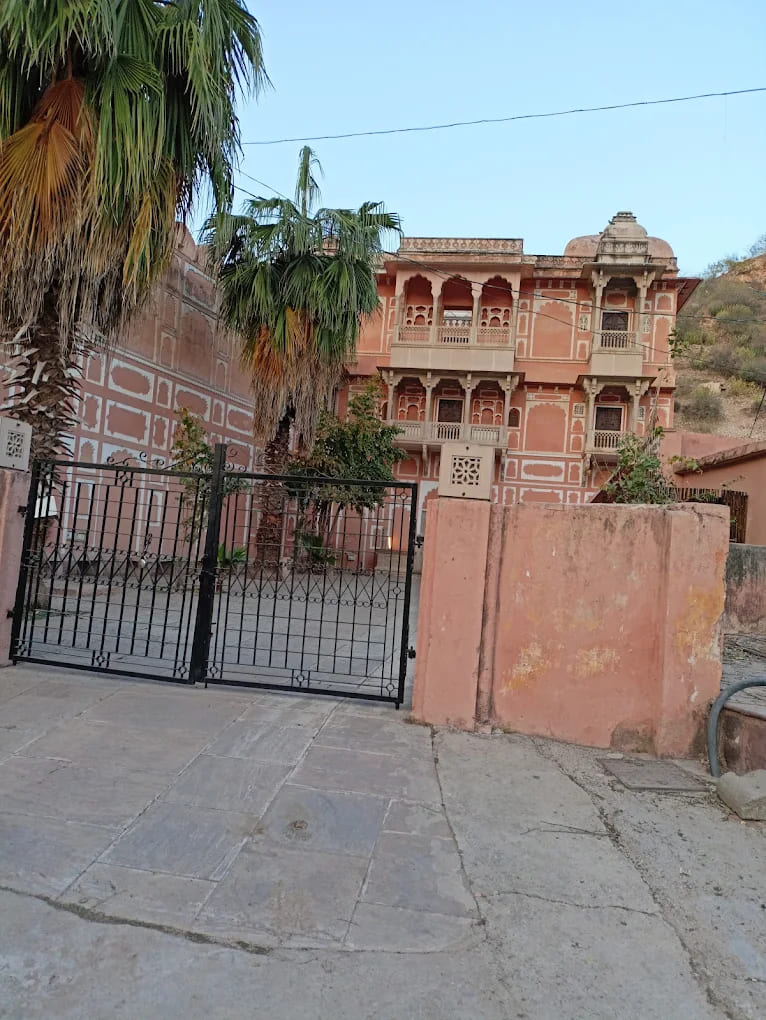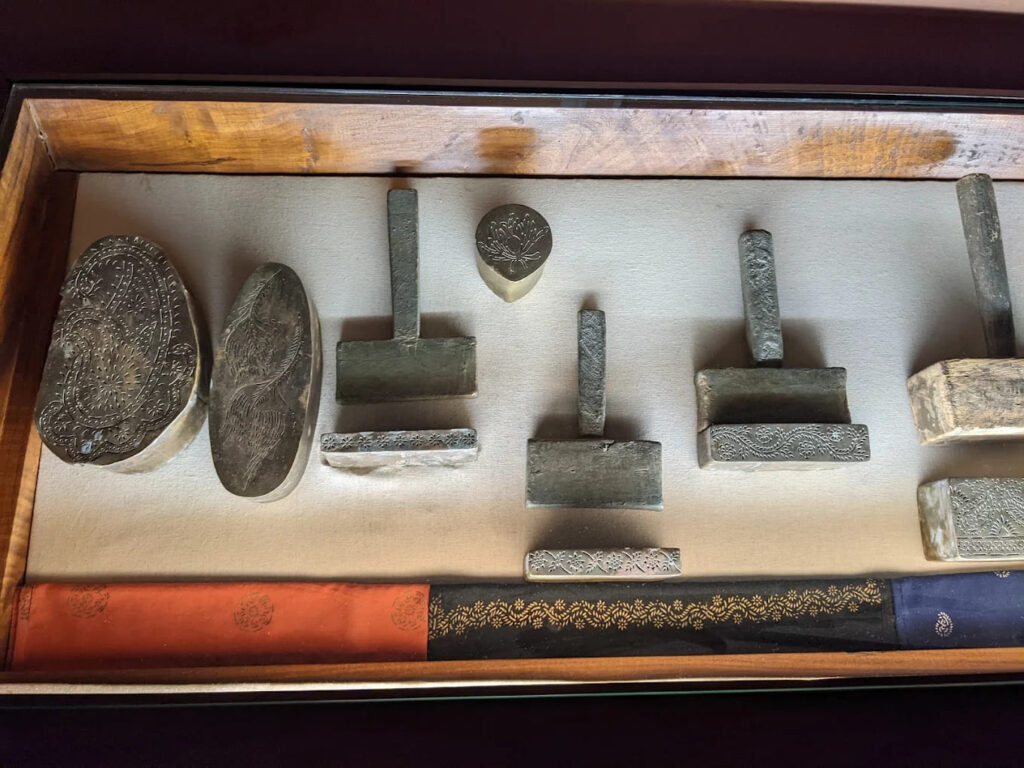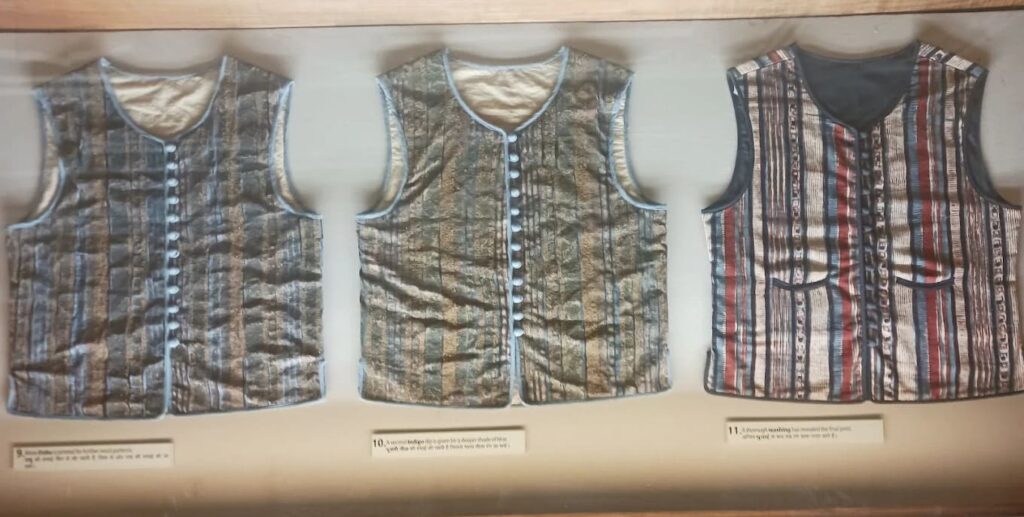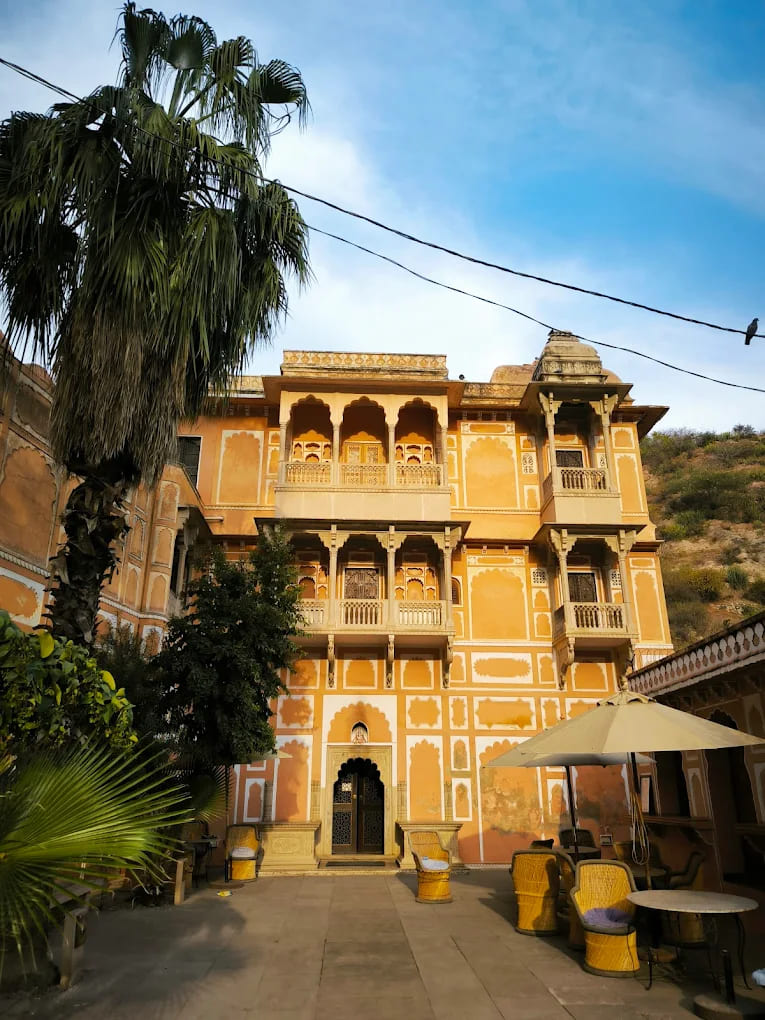Tucked away in the historic town of Amber, just a short drive from Jaipur, the Anokhi Museum of Hand Printing is a hidden gem that celebrates one of India’s oldest and most sustainable art forms hand block printing.
Housed in a beautifully restored 17th-century haveli, this boutique museum stands as a living tribute to Rajasthan’s textile heritage and the artisans who have kept the craft alive for generations.

Founded by the Anokhi Foundation in 2005, the museum was created to preserve, document, and promote the traditional techniques of block carving, dyeing, and printing that originated in nearby villages such as Sanganer and Bagru. Visitors here don’t just see art, they experience it firsthand through interactive displays, live demonstrations, and hands-on workshops.
Every gallery tells a story from the making of hand-carved teakwood blocks to the natural dyes extracted from plants and minerals. The gentle scent of indigo and the rhythmic sound of artisans printing fabrics transform this museum into a multisensory journey through India’s textile legacy.
For those who seek authenticity and craftsmanship beyond the royal palaces of Jaipur, the Anokhi Museum of Hand Printing offers an inspiring encounter with design, sustainability, and heritage all under one roof.
Also Check: Albert Hall Museum Jaipur
History & Background of Anokhi Museum Jaipur
The Anokhi Museum of Hand Printing (AMHP) was established in 2005 by the Anokhi Foundation, an extension of the famous Jaipur-based clothing brand Anokhi, which is known for its commitment to ethical fashion and handcrafted textiles. The foundation’s goal was simple yet profound to preserve, document, and revive the traditional art of hand block printing, a technique deeply rooted in Rajasthan’s cultural identity.
A Tribute to Rajasthan’s Textile Legacy
The museum was set up to honor the craftsmen and communities who have kept this centuries-old printing technique alive in villages like Sanganer and Bagru. These regions are world-renowned for their block-printed fabrics, known for their delicate floral patterns, natural dyes, and artistic detailing.
By creating this museum, Anokhi sought to ensure that the art of hand block printing once threatened by industrialization could thrive again through education, awareness, and appreciation.

Housed in a Restored Heritage Haveli
The museum is located inside the beautifully restored Chanwar Palkiwalon ki Haveli, a 17th-century mansion situated near Amber Fort. This architectural marvel was meticulously restored over three years using traditional building techniques, ensuring that the structure retained its old-world charm while functioning as a modern museum space.
The haveli itself is an exhibit featuring stone-carved balconies, arched courtyards, jharokhas, and frescoed walls, it provides the perfect backdrop for showcasing Rajasthan’s artistic heritage.
A Vision by the Anokhi Foundation
The Anokhi Foundation envisioned this museum not merely as a static display but as a living institution where visitors can learn, engage, and participate in the craft. Through curated exhibits, films, and live workshops, the foundation connects traditional craftsmanship with contemporary sustainability a principle that has defined Anokhi’s design philosophy for decades.
Architectural Beauty of the Haveli
One of the most enchanting aspects of the Anokhi Museum of Hand Printing is its architectural setting the exquisitely restored Chanwar Palkiwalon ki Haveli in Amber. This 17th-century mansion, once home to noble families, has been lovingly transformed into a museum that embodies the grace and craftsmanship of Rajasthan’s royal past.
1. A Fine Example of Rajput Architecture
The haveli showcases the distinctive elements of traditional Rajput architecture, including:
- Jharokhas (ornate balconies) that overlook narrow stone lanes.
- Carved wooden doors and windows that feature intricate latticework.
- Open courtyards and arched corridors designed for natural light and airflow.
- Walls adorned with subtle frescoes and lime plaster work, reflecting the artistic finesse of the period.
The structure perfectly blends local craftsmanship with sustainable design principles, echoing the very essence of the block-printing art it houses.
2. A Model for Sustainable Restoration
The restoration of the haveli was a labor of love carried out by the Anokhi Foundation over several years.
- Artisans used traditional lime mortar, local sandstone, and handcrafted fittings to retain its authenticity.
- Modern additions were kept minimal, ensuring the architectural integrity of the space was preserved.
- The project won the UNESCO Asia-Pacific Heritage Conservation Award for its exemplary approach to heritage restoration and adaptive reuse.
This careful conservation effort turned a forgotten historical structure into a vibrant center for cultural education and craft revival.
3. The Perfect Setting for Textile Heritage
The layout of the haveli enhances the visitor experience each gallery and courtyard narrates a different aspect of the block-printing journey.
- Ground floor: Exhibits the tools, dyes, and wooden blocks used in printing.
- Upper floors: Display exquisite textiles and finished garments.
- Terraces and courtyards: Offer panoramic views of Amber and glimpses of artisans at work.
Every corner of the haveli tells a story from carved columns to sunlit verandas, the building itself becomes part of the museum’s artistic dialogue.
Exhibits & Displays Inside the Anokhi Museum Jaipur
The Anokhi Museum of Hand Printing offers an extraordinary glimpse into the world of traditional Rajasthani block printing, from the tools and techniques used by artisans to the evolution of patterns and textiles through history. Spread across multiple galleries within the restored haveli, the museum combines education, aesthetics, and live demonstrations to create an immersive experience for visitors.
1. The Wooden Block Gallery
One of the museum’s most fascinating sections is dedicated to hand-carved wooden printing blocks — the foundation of this ancient craft.
- Visitors can see hundreds of intricately designed blocks arranged by motif, region, and technique.
- Each block is carved from seasoned teakwood and showcases motifs inspired by nature, geometry, and Mughal art.
- The gallery demonstrates how a single block can be used repeatedly to create stunningly complex textile patterns.
2. Natural Dyes & Pigments
The museum beautifully explains the process of creating natural dyes from plants, roots, and minerals a sustainable practice that defines Rajasthan’s block-printing heritage.
- Exhibits include samples of indigo, madder, pomegranate, and turmeric dyes.
- Informational displays show how artisans prepare, mix, and apply these dyes to achieve vibrant, long-lasting colors.
- The focus on eco-friendly practices reflects Anokhi’s philosophy of sustainability and environmental consciousness.
3. Fabric & Textile Collections
This section features an impressive range of block-printed textiles that highlight both traditional and contemporary applications of the art form.
- From vintage saris and dupattas to modern garments and home décor pieces, the collection bridges craftsmanship with design evolution.
- Displays include examples of Bagru and Sanganer prints, Ajrakh-inspired motifs, and limited-edition Anokhi designs.
- Visitors can compare printing styles from different regions and eras, showcasing India’s incredible textile diversity.
4. Demonstration Area
Perhaps the most engaging part of the museum, the demonstration area allows visitors to witness artisans practicing the traditional hand block printing process.
- Craftsmen demonstrate each stage carving, dye mixing, and stamping on cotton and silk fabrics.
- Guests are encouraged to interact with the artisans and even try printing their own design as a keepsake.
- These live sessions bring the entire exhibit to life, creating a bridge between museum learning and hands-on experience.
5. Temporary Exhibitions & Special Displays
In addition to its permanent exhibits, JKK regularly curates temporary exhibitions that explore topics such as:
- Modern interpretations of block printing in fashion and interior design.
- The role of women artisans in Rajasthan’s textile traditions.
- Collaborations between local craftsmen and global designers.
These exhibits ensure that the museum remains dynamic, educational, and ever-evolving.
The Art of Hand Block Printing
At the heart of the Anokhi Museum of Hand Printing lies the ancient craft it celebrates the art of hand block printing, a practice that has adorned Indian textiles for over 500 years. This traditional method combines skill, patience, and creativity, producing fabrics that are as sustainable as they are stunning.

1. The Craftsmanship Behind Each Print
Hand block printing begins with the artisans known as chhipas families who have passed down their skills for generations in villages like Bagru and Sanganer, near Jaipur.
- The process starts with the carving of intricate designs into wooden blocks made of teak or sheesham wood.
- These blocks are then used to stamp dye onto fabric, layer by layer, forming complex patterns that can take hours or even days to complete.
- Each block represents a separate color, meaning a single motif might require multiple blocks for precision alignment.
This meticulous, hands-on process ensures that no two fabrics are ever identical, making each piece a one-of-a-kind work of art.
2. Natural Dyes & Eco-Friendly Practices
One of the most fascinating aspects of block printing is its eco-conscious approach.
- Artisans use natural dyes extracted from plants, roots, and minerals indigo for blue, madder root for red, pomegranate rind for yellow.
- Fabrics are washed in rivers, sun-dried, and treated with natural mordants to fix the colors.
- The process reflects sustainability long before it became a modern trend, a philosophy deeply aligned with Anokhi’s brand ethos.
3. Patterns & Motifs: Tradition Meets Design
Each region of Rajasthan has its own signature motifs and styles:
- Sanganer prints are known for delicate floral designs and pastel shades.
- Bagru prints feature bold geometric patterns and earthy tones.
- Modern Anokhi designs blend both, creating timeless yet contemporary textiles.
At the museum, visitors can trace this evolution of design from royal patronage during the Mughal era to the minimalist aesthetics of modern fashion.
4. Education Through Experience
The Anokhi Museum doesn’t just display block printing it teaches it. Visitors can observe artisans at work, understand each step, and even try their hand at printing under expert guidance.
This interactive approach bridges the gap between museum learning and living craft, ensuring that the tradition continues to inspire future generations.

Workshops & Demonstrations at Anokhi Museum Jaipur
One of the most unique aspects of the Anokhi Museum of Hand Printing is that it doesn’t just showcase history it brings it to life. The museum regularly conducts workshops and live demonstrations that allow visitors to step into the shoes of artisans and experience the traditional craft of hand block printing firsthand.
1. Live Printing Demonstrations
Inside the museum’s open courtyard, you’ll often find skilled chhipa artisans demonstrating the delicate art of block printing.
- Watch as they dip hand-carved wooden blocks into trays of vibrant natural dyes and stamp fabrics with rhythmic precision.
- The process reveals how patience, timing, and technique come together to create symmetrical, artistic designs.
- Each demonstration explains the tools, materials, and dyeing methods involved, offering visitors a rare behind-the-scenes perspective on a craft that has remained unchanged for centuries.
These live sessions turn a simple visit into a sensory experience the sound of stamping, the smell of dyes, and the visual poetry of handmade design.
2. Hands-On Workshops
For those who want to do more than just observe, the museum offers interactive workshops where visitors can learn and practice printing themselves.
- Under the guidance of trained artisans, participants can choose a design block, apply color, and print on fabric creating their very own souvenir to take home.
- Workshops are suitable for all ages and often organized for students, designers, and art enthusiasts.
- The sessions promote sustainability and appreciation for slow craft, showing how traditional techniques can thrive even in the modern design world.
3. Learning Beyond Printing
In addition to printing sessions, the museum also occasionally conducts educational programs and talks on textile heritage, covering topics like:
- Natural dye extraction and fabric preparation.
- Preservation of textile crafts in India.
- The influence of block printing on global fashion.
These activities are perfect for those interested in art, design, or sustainable fashion, making the Anokhi Museum an invaluable educational hub.
Also Check: Jawahar Kala Kendra Jaipur
Museum Shop & Café at Anokhi Museum Jaipur
After exploring the colorful galleries and live demonstrations, visitors can unwind at the Museum Shop and Café, both located within the serene courtyards of the Anokhi Museum of Hand Printing. These spaces extend the museum’s philosophy of craftsmanship, sustainability, and mindful living, allowing guests to take a part of Rajasthan’s artisanal heritage home with them.
1. The Anokhi Museum Shop
The museum shop is a treasure trove of handcrafted textiles and lifestyle products, all made using traditional block printing techniques.
- You’ll find an exquisite selection of hand-printed garments, stoles, home linens, stationery, bags, and accessories, each piece reflecting Anokhi’s signature design aesthetic.
- Every product sold here is ethically sourced and made by local artisans, ensuring fair wages and sustainable livelihoods.
- Visitors can also explore limited-edition prints and exclusive designs not available in regular Anokhi stores.
Each purchase supports the preservation of traditional crafts, making it more than just shopping it’s a way to contribute to India’s living heritage.
2. The Anokhi Café
Adjacent to the museum courtyard, the Anokhi Café offers a peaceful retreat from Amber’s bustling streets.
- With its rustic interiors, leafy courtyard, and calming ambiance, the café is a perfect spot to relax after exploring the museum.
- The menu focuses on fresh, locally sourced, and organic ingredients, offering light meals, desserts, and refreshing beverages.
- Popular picks include lemon cake, quiche, and herbal teas, along with regional snacks that complement the museum’s cultural vibe.
Whether you’re sipping coffee while admiring the architecture or browsing through your block-printed souvenirs, the café perfectly blends art, comfort, and creativity.
3. Sustainability in Design
Both the shop and café reflect Anokhi’s sustainability ethos, from eco-friendly packaging to the use of natural fabrics, recycled paper, and biodegradable materials. The entire setup embodies the museum’s mission to inspire conscious living and responsible tourism.
Location & How to Reach Anokhi Museum Jaipur
The Anokhi Museum of Hand Printing is located in the heritage town of Amber, about 11 km from Jaipur city center, just a few minutes away from the iconic Amber Fort. Its peaceful setting among narrow lanes and historic havelis makes it one of the most scenic museum experiences in Rajasthan.
Address
Anokhi Museum of Hand Printing
Chanwar Palkiwalon ki Haveli, Kheri Gate, Amber, Jaipur, Rajasthan – 302028
Google Map Location: https://maps.app.goo.gl/8U4PvZk41H1oiRyVA
Landmark: Near Amber Fort and Panna Meena ka Kund
How to Reach Anokhi Museum
By Cab or Auto-Rickshaw
- The easiest way to reach the museum is by cab or auto-rickshaw from Jaipur city.
- It takes about 25–30 minutes from central Jaipur areas like MI Road or Bani Park.
- Popular cab services such as Ola and Uber are available and know the location well.
By Local Bus
- Public buses heading toward Amber Fort frequently stop near the museum area.
- Ask for a stop near Kheri Gate Amber, from where the museum is a 5-minute walk.
By Two-Wheeler or Car
- You can drive via Amer Road (NH 248). Parking is available near the Amber Fort parking area, from where you can take a short walk uphill to the museum.
By Foot (from Amber Fort)
- If you’re visiting Amber Fort, you can simply walk to the museum it’s located just 500 meters downhill from the fort’s main entrance.
- The path passes through picturesque stone alleys and old havelis, offering a glimpse into Amber’s rustic charm.
Timings & Entry Fee of Anokhi Museum Jaipur
Before planning your visit to the Anokhi Museum of Hand Printing, it’s important to know its operating hours, weekly schedule, and entry details. The museum maintains visitor-friendly timings and affordable entry fees to encourage art lovers, students, and tourists to explore Rajasthan’s textile heritage.
Anokhi Museum Jaipur Timings
| Day | Timings |
|---|---|
| Tuesday – Saturday | 10:30 AM – 5:00 PM |
| Sunday | 11:00 AM – 4:30 PM |
| Monday | Closed |
🕰️ Last Entry: 30 minutes before closing time.
📅 Closed on: Mondays, certain public holidays, and during exhibition setup periods (check social media or official site for updates).
Entry Fee
| Visitor Type | Ticket Price |
|---|---|
| Indian Visitors | ₹30 per person |
| Foreign Visitors | ₹50 per person |
| Students (with ID) | ₹20 per person |
| Children under 10 years | Free entry |
Nearby Attractions Around Anokhi Museum Jaipur
Located in the historic town of Amber, the Anokhi Museum of Hand Printing sits amidst some of Jaipur’s most magnificent heritage landmarks. A visit here can easily be combined with other nearby attractions, making it an ideal stop for a half-day cultural and architectural tour.
1. Amber Fort (0.5 km)
- The Amber Fort, a UNESCO World Heritage Site, is the most famous landmark near the Anokhi Museum.
- Built in the 16th century, the fort showcases Rajput-Mughal architecture and offers panoramic views of Maota Lake.
- Don’t miss the Sheesh Mahal (Mirror Palace) and the light & sound show in the evening.
2. Panna Meena ka Kund (0.4 km)
- This ancient stepwell is one of Jaipur’s most photogenic spots, located a short walk from the museum.
- Known for its symmetrical staircases and geometric design, it was once used for water storage and community gatherings.
3. Jaigarh Fort (3 km)
- Perched on the Aravalli hills above Amber Fort, Jaigarh Fort houses the world’s largest cannon on wheels Jaivana.
- It offers breathtaking views of the surrounding hills and the Amber complex below.
4. Nahargarh Fort (8 km)
- Built as a defense fort overlooking Jaipur city, Nahargarh is famous for its sunset views and the Padao Café.
- It’s part of the trio of forts Amber, Jaigarh, and Nahargarh that form Jaipur’s royal defense ring.
5. Elefantastic (2 km)
- A popular ethical elephant sanctuary where visitors can feed, bathe, and learn about elephants in a responsible way.
- Great for families and animal lovers seeking an interactive experience.
6. Anokhi Boutique Store (11 km, Jaipur City)
- After visiting the museum, art lovers can explore the main Anokhi store in Jaipur city for an extended collection of block-printed apparel and accessories.
FAQs About Anokhi Museum Jaipur
What is the Anokhi Museum of Hand Printing famous for?
The Anokhi Museum of Hand Printing is famous for preserving and promoting the traditional art of hand block printing from Rajasthan. It showcases antique wooden blocks, natural dye techniques, vintage textiles, and live demonstrations by artisans offering a complete insight into this centuries-old craft.
Where is the Anokhi Museum located?
It is located in Amber, about 11 km from Jaipur city center, inside the beautifully restored Chanwar Palkiwalon ki Haveli, near Amber Fort.
Address: Chanwar Palkiwalon ki Haveli, Kheri Gate, Amber, Jaipur, Rajasthan – 302028.
What are the Anokhi Museum Jaipur timings?
Tuesday – Saturday: 10:30 AM – 5:00 PM
Sunday: 11:00 AM – 4:30 PM
Closed on Mondays and certain holidays.
What is the entry fee for Anokhi Museum Jaipur?
Indian Visitors: ₹30 per person
Foreign Visitors: ₹50 per person
Students: ₹20 (with valid ID)
Children below 10 years: Free entry
Who founded the Anokhi Museum?
The museum was founded by the Anokhi Foundation, an initiative of the Anokhi clothing brand, known globally for its handcrafted, block-printed fashion.
What can visitors see at the Anokhi Museum?
Visitors can explore:
Hand-carved wooden printing blocks.
Natural dye exhibits and traditional textile collections.
Live block-printing demonstrations and artisan workshops.
The museum shop and café offering handcrafted products and refreshments.
Is photography allowed inside the museum?
Yes, photography is allowed in outdoor courtyards and during live demonstrations. However, some galleries may restrict photography please check signage or consult museum staff.
How much time is needed to explore the museum?
A typical visit takes 1.5 to 2 hours to explore all galleries, demonstrations, and the café. If you participate in a workshop, allow 3 hours or more for a complete experience.
How can I reach the Anokhi Museum from Jaipur city?
You can take a cab, auto-rickshaw, or local bus to Amber Fort and walk a short distance (approx. 500 meters) downhill to reach the museum. It’s about a 25–30 minute drive from Jaipur city center.
What are the nearby attractions to Anokhi Museum?
Nearby attractions include Amber Fort, Panna Meena ka Kund, Jaigarh Fort, Nahargarh Fort, and Elefantastic all within a few kilometers of the museum.
